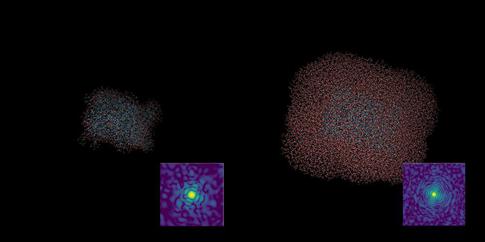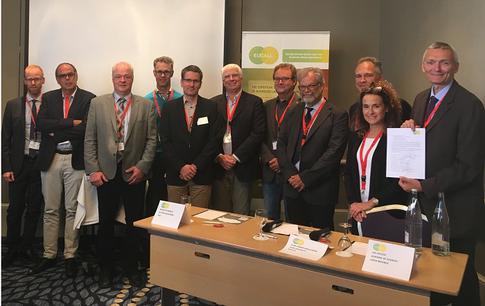XFEL: EUCALL collaboration: taking stock
EUCALL collaboration: taking stock
They both are large facilities, and they both produce intense X-rays. Although these facilities create X-rays in very different ways, they do have a lot in common. Funded with 7 million euro and started in 2015, the EU project EUCALL (European Cluster of Advanced Laser Light Sources) brought together scientists from two different scientific communities: Scientists doing research at and building synchrotrons or free-electron lasers based on radiofrequency acceleration, and scientists working on the generation and use of X-rays generated by advanced lasers in the near-visible regime. During the three-year project, experts from across Europe worked together to develop solutions for challenges common to these facilities and their communities. The results include new methods for not only data analysis, diagnostic, simulation, and sample delivery technologies, but also for standardizing processes to further increase the efficiency of both types of facilities.
One of the results of this collaboration is SIMEX (Simulations of Experiments), a simulation software package that helps predict experiment outcomes and can model experiments at X-ray lasers, synchrotrons, or optical laser research facilities. Another one is the UFDAC (Ultrafast Data Acquisition) firmware that speeds up the data transfer from detectors to data servers, thus allowing users of high data rate experiments to directly observe the build-up of data and to adjust settings on the fly. A third example is HIREP (High Repetition Sample Delivery), a sample delivery method using artificial intelligence to identify interesting areas on target films and to position these with high precision in the path of an X-ray beam. Other sustainable results of the successful collaboration are the augmentation of the Wayforlight database with more detailed specifications of 121 beamlines from across Europe, as well as the future EUCALL forum that will continue to act as a bridge between the different communities.

One example of the technologies developed through EUCALL: SIMEX, a simulation platform that allows scientists to virtually run X-ray imaging experiments. In this example, a protein (left) is virtually imaged using an X-ray laser, resulting in the diffraction pattern next to the molecule. However, if the protein is surrounded by a 20-Angstrom-thick layer of water molecules--a state commonly seen with such biomolecules--then the simulation shows how the diffraction pattern is distorted by the water's presence. These details can help scientists better prepare for their experiments and understand possible results before spending valuable time at a scientific instrument figuring out subtleties in the experiment. (Image: European XFEL)
“EUCALL brought together for the first time two separate scientific communities, albeit experiencing similar experimental demands and technical challenges” explains EUCALL project coordinator and European XFEL Scientific Director Thomas Tschentscher. “It has been very useful to exchange and share experiences and to identify and solve issues common to synchrotron light sources, free-electron lasers, and high-power optical lasers. We very much hope this momentum will continue far beyond the end of the project itself.”
EUCALL focused on European XFEL, the European Synchrotron Radiation Facility (ESRF) in France, and the Extreme Light Infrastructure (ELI) in Czechia, Hungary, and Romania. In addition, five national research centres took part in the project: Deutsches Elektronen-Synchrotron (DESY) and Helmholtz Zentrum Dresden-Rossendorf (HZDR) in Germany, the Paul Scherrer Institut (PSI) in Switzerland, Lund University in Sweden, and Elettra Sincrotrone Trieste in Italy. Two Europe-wide networks of facilities, FELs of Europe and Laserlab-Europe, also were part of EUCALL. The project was expanded to include further associate partners, Laboratoire pour l’Utilisation des Lasers Intenses in France and Forschungszentrum Jülich in Germany.
Technological and structural advancements developed through EUCALL include:
SIMEX (Simulations of Experiments) is a modular simulation software package that provides precise predictions of experiment outcomes. The software can model any photon science experiment at any X-ray laser, synchrotron, or optical laser research facility. Users can employ SIMEX to pre-run their experiments and use the simulated results to find the best settings for the real experiment, saving precious experiment time at user facilities. Since its initial development early in EUCALL’s three-year run, SIMEX has already become a popular tool worldwide.
UFDAC (Ultrafast Data Acquisition) firmware makes transferring data from detector to data server much faster. The algorithms developed by UFDAC avoid any actions that slow processing time on either the computers doing the processing or the transfer lines between them. Tests show that the algorithms can handle a transfer rate of 10 GB per second. The high speed helps to directly observe experiments as they take place, helping users adjust settings on the fly.
HIREP (High Repetition Sample Delivery) is a standardized sample delivery method for identifying interesting targets and positioning them in the path of an X-ray beam at a rate of 10 times per second. HIREP relies on a standard frame to hold samples of various types. The system uses artificial intelligence to find areas that are of interest on a sample and communicates their position in the context of the frame via a barcode to a scanner. This setup can be installed at any light source.
PUCCA (Pulse Characterization and Control) is a suite of diagnostic tools that help scientists do research at shorter timescales and at higher energies of light. The tools assist scientists with narrowing the range of time of a process or interaction or help identify the quality of the X-ray beam. These tools, when paired with UFDAC software, can help scientists keep a real-time view of the properties of the light.
For more information and to download the software developed within the framework of EUCALL visit: https://github.com/eucall-software
The Wayforlight database comprises comprehensive data regarding the specifications of over 300 beamlines from across Europe. A study of European light source beamlines resulted in augmentation of the database with more information on 121 beamlines, including the addition of the optical laser facilities of Europe. Wayforlight is an international portal for accelerator light sources that is part of the EU-funded CALIPSOplus project. The database helps users identify the most suitable instrumentation for their experimental goals. www.wayforlight.eu/en/
EUCALL Forum, currently being established, will continue to act as a bridge between accelerator-based and laser-based light sources beyond the end of the project.

EUCALL has received funding from the European Union's Horizon 2020 research and innovation programme under grant agreement No 654220.
